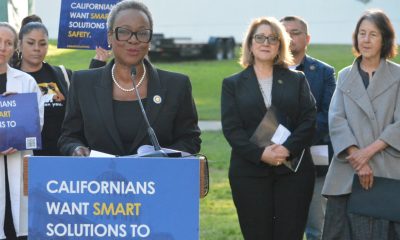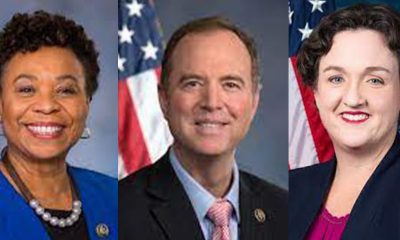Health
Blacks Gain Most from Obamacare When Medicaid Expanded

This Nov. 29, 2013, file photo shows a part of the HealthCare.gov website, photographed in Washington. (AP Photo/Jon Elswick, File)
By Freddie Allen
NNPA Senior Washington Correspondent
WASHINGTON (NNPA) – As families prepare to choose health insurance coverage during the open enrollment period, a recent report by the Urban Institute shows that Blacks have the most to gain from the Patient Protection and Affordable Care Act (ACA) if the states they live in expand Medicaid under the law.
The Urban Institute, a nonprofit research group focused on social and economic policy, estimated that Blacks will experience, “the largest decreases in uninsurance rates under full Medicaid expansion: a drop from 11.3 percent (projected with current expansion decisions) to 7.2 percent” and the uninsurance rate gap between Blacks and Whites will fall from 6.5 percent under current Medicaid expansion to 2.6 percent with full expansion.
However, the gap between Black and White uninsurance rates will remain closer to 7 percent, at least for the near future, because most Blacks live in states that have refused to expand Medicaid under the ACA.
The original law, passed in 2010, mandated Medicaid expansion nationwide, but the United States Supreme Court 2012 decision in the National Federation of Independent Business v. Sebelius case reversed that provision, leaving it to the states to decide whether they want to take additional Medicaid funding under the ACA.
According to the Urban Institute, “As of December 2014, 27 states and the District of Columbia had expanded Medicaid or planned to expand by January 2015.”
The Urban Institute projected that Blacks would comprise 12.8 percent of all coverage gains under current Medicaid expansion policies and 2.9 million Blacks would get health insurance. The uninsurance rate for Blacks would fall from 19.6 percent to 11.3 percent.
More than half of all Blacks live in states, primarily in the South and led by Republican governors, that didn’t expand Medicaid after the ACA was passed in 2010.
When states refused to expand Medicaid, the move trapped Blacks in a “coverage gap,” because many of them don’t meet the income-based requirements to qualify for Medicaid under their own state rules or to receive subsidies through the ACA marketplace.
About 1.4 million Blacks fall into this category, accounting for more than 23 percent of the uninsured non-elderly adult Blacks. For example, in Florida, Georgia, Texas and North Carolina, the uninsured rates for Blacks would plummet roughly 30 percent compared to current rates, if those states expanded Medicaid coverage under the ACA.
“For blacks, however, the difference between their uninsurance rates and whites’ rates is projected to narrow under the ACA with current Medicaid expansion decisions only in Medicaid expansion states,” the report said. “Across all states, the difference in uninsurance rates between blacks and whites is projected to stay approximately the same both under the ACA with current Medicaid expansion decisions and without the ACA.”
In August 2014, researchers with the Urban Institute said that 6.7 million residents would still remain uninsured in 2016 in the states that continued to block Medicaid expansion through the ACA.
“These states are foregoing $423.6 billion in federal Medicaid funds from 2013 to 2022, which will lessen economic activity and job growth,” the August 2014 report said. “Hospitals in these 24 states are also slated to lose a $167.8 billion (31 percent) boost in Medicaid funding that was originally intended to offset major cuts to their Medicare and Medicaid reimbursement.”
The report continued: “For every $1 a state invests in Medicaid expansion, $13.41 in federal funds will flow into the state.”
The Council of Economic Advisers (CEA), a small group that offers the president domestic and foreign economic advice, predicted that, Medicaid expansion would have added, in nonexpanding states, nearly 79,000 jobs in 2014, “172,400 jobs in 2015, and 98,200 jobs in 2016.”
The August 2014 report also noted that that the rate of uninsured in the states that expanded Medicaid fell by nearly 40 percent, since September 2013, the number of uninsured in the non-expansion states fell by less than 10 percent.
The technical difficulties that plagued the rollout of HealthCare.gov last year have faded from headlines, and the benefits of Medicaid expansion under the Affordable Care Act become harder for governors and state legislators to dismiss.
In December, Republican Tennessee Gov. Bill Haslam moved to expand Medicaid under the ACA, leaving less than two dozen states to weigh providing health care for their poorest residents against future costs associated with Medicaid.
The Urban Institute report on uninsurance rates under the ACA said that improving health literacy, translation services, outreach through ethnic media and working with trusted members of the community can also aid in driving down the levels of uninsured.
According to a recent report by the Department of Health and Human Services (HHS), 87 percent of the people who selected health insurance plans through HealthCare.gov were eligible for financial assistance, a 7 percent increase over last year’s numbers.
“That includes more than 3.4 million people who selected a plan in the 37 states that are using the HealthCare.gov platform for 2015, and more than 600,000 consumers who selected plans in the 14 states that are operating their own Marketplace platform for 2015,” stated a press release on the report.
A more detailed view of enrollment data collected from November 15 to December 26 showed that roughly 6.5 million people either selected plans or were automatically reenrolled.
HHS Secretary Sylvia Burwell said that the vast majority of people who signed up for health insurance coverage through HealthCare.gov were able to lower their costs using tax credits.
“Interest in the Marketplace has been strong during the first month of open enrollment,” Burwell said in a recent press release about the enrollment report. “We still have a ways to go and a lot of work to do before February 15, but this is an encouraging start.”
###
Community
For Cervical Cancer Month, Medical Community Focused on Education
January was Cervical Cancer Awareness Month. Physicians, advocates and others in the medical community commemorated the month by raising awareness about a form of cancer they say is highly preventable and treatable. Cervical cancer is caused by a virus called the human papillomavirus (HPV) and it develops slowly over time but can be prevented with proper care in girls as young as 13 years old.

By Magaly Muñoz
January was Cervical Cancer Awareness Month.
Physicians, advocates and others in the medical community commemorated the month by raising awareness about a form of cancer they say is highly preventable and treatable.
Cervical cancer is caused by a virus called the human papillomavirus (HPV) and it develops slowly over time but can be prevented with proper care in girls as young as 13 years old.
Sonia Ordonez, an OBGYN and gynecology surgeon at Kaiser Permanente, stated that as soon as people with cervixes reach the maturity reproductive age, they should start taking preventative measures like getting the HPV vaccine. The vaccine involves a series of two-doses for people aged 9 through 14 or three-doses for people 15 through 45 years old.
“I see a lot of young women who can’t remember or may not have gotten [the vaccine] when they were younger, or maybe got one, but we can give them the series of vaccines and restart at any point in time,” Ordonez said.
She said that cervical cancer is not the only cancer caused by HPV. Strains of the virus can also lead to throat, anal and penile cancers.
Screening is also an effective way to check for cervical cancer and should be done every three years after someone turns 21, doctors recommend. It is best to start as early as possible to catch occurrences early.
Ordonez said that this cancer is also more likely found in people of color and has led to more deaths overall.
A Mayo Clinic article published last month stated that Black women are more likely to be diagnosed and die of cervical cancer, compared to White women in the U.S.
2,000 Black women are diagnosed every year with cervical cancer and 40% die as a result.
“This disparity is not due to genetic differences among White, Black or Hispanic women, but rather related to systemic racism, access to healthcare and socioeconomic factors,” Dr. Olivia Cardenas-Trowers, a Mayo Clinic urogynecologist, said in the article.
Ordonez stated that immigrant women are also highly susceptible to the cancer, as many Latin American countries may not have accessibility to screenings or lack of insurance makes it harder for them to get tested.
Hispanic women are 40% more likely to be diagnosed with cervical cancer, and 30% more likely to die from it, as compared to non-Hispanic White women, according to the Office of Minority Health.
Family medicine physician, Joy Anyanwu, stated that the pandemic contributed to hesitancy about getting cervical cancer screenings among some women. Other factors are people’s aversion to vaccines, parents not wanting to believe that their children are or will become sexually active, and doubt about the overall effectiveness of the vaccine.
“The vaccine is very safe — over 97% effective in preventing cervical cancer,” Anyanwu said. “Even if you aren’t having sex, the earlier you start would actually help.”
Anyanwu said she understands that parents might not want to ask questions about their children’s reproductive health, but it’s a mindset that can be a barrier to having important conversation about prevention or care.
To keep families their families and communties healthy, the doctor emphasized that people should prioritize keeping up with their vaccine series and going to screenings every year.
Antonio Ray Harvey
Sacramento Lawmakers Step Up Push for “Smart Solutions” on Crime, Public Safety
Assemblymember Tina McKinnor (D-Inglewood) and Sen. Lola Smallwood-Cuevas (D-Ladera Heights), both members of the California Legislative Black Caucus (CLBC), have joined other lawmakers and criminal justice reform advocates to address public safety in the state. On April 2, CLBC members gathered outside the State Capitol for the unveiling of the #SmartSolutions Public Safety Policy Platform, a package of 30 bills that addresses the top concerns of retailers, retail workers, the fentanyl crisis, and support for victims and survivors of crime.
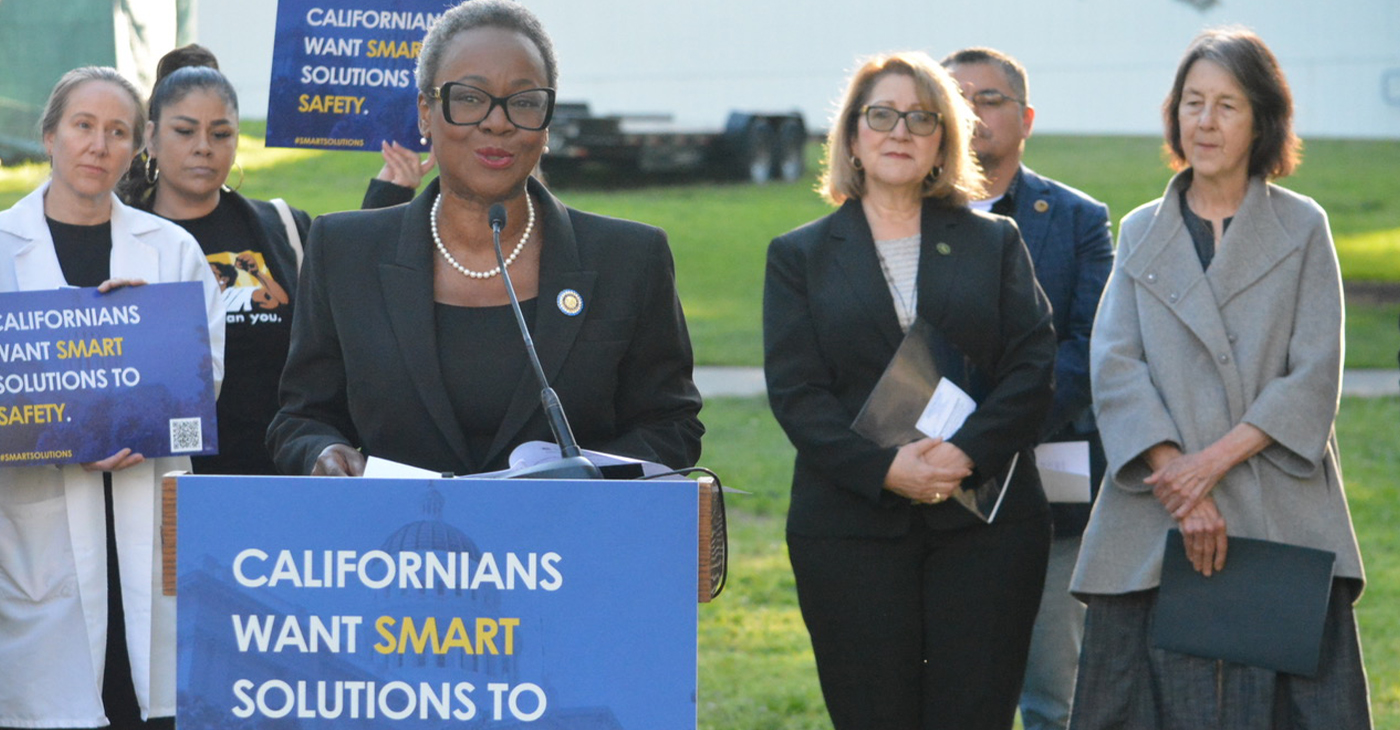
By Antonio Ray Harvey, California Black Media
Assemblymember Tina McKinnor (D-Inglewood) and Sen. Lola Smallwood-Cuevas (D-Ladera Heights), both members of the California Legislative Black Caucus (CLBC), have joined other lawmakers and criminal justice reform advocates to address public safety in the state.
On April 2, CLBC members gathered outside the State Capitol for the unveiling of the #SmartSolutions Public Safety Policy Platform, a package of 30 bills that addresses the top concerns of retailers, retail workers, the fentanyl crisis, and support for victims and survivors of crime.
“Instead of being tough on crime, we need to be smart on crime,” Smallwood said at the press briefing. “I am not saying that we’re not going to be holding folks accountable for the actions that they take. But we will not rely on incarceration as a solution.”
McKinnor, Smallwood-Cuevas, a coalition of advocates, addiction treatment experts, and Yurok Tribal leaders joined Sen. Nancy Skinner (D-Berkeley), and Assemblymember Eloise Gómez Reyes (D-Colton) at the press conference organized to promote legislative solutions that ensure safety and justice.
Organizers say #SmartSolutions is an intersectional campaign that combats criminalization and mass incarceration by pushing for the redirection of state resources to fund housing, health care, schools, services for victims, and programs that reduce recidivism and promote accountability, beyond incarceration.
Opponents of the bills proposed in the #SmartSolutions campaign say their colleagues who support reform-focused strategies are looking the other way on crime and encouraging lawlessness.
For example, Assemblymembers Wendy Carillo (D-Boyle Heights), Carlos Villapudua (D-Stockton) and Mike Gipson (D-Carson) are supporting Assembly Bill (AB) 1990, legislation that would allow a peace officer to arrest shoplifters without a warrant or without witnessing the theft.
Assemblymember James Ramos (D-Highland) authored AB 1772 and introduced it in January. The legislation proposes sterner penalties for retail theft, particularly for repeat offenders.
The #SmartSolutions campaign is co-sponsored by Ella Baker Center for Human Rights, Smart Justice California, American Civil Liberties Union (ACLU) California Action, Californians for Safety and Justice, and Californians United for a Responsible Budget (CURB).
Smallwood recently introduced two bills she hopes will provide solutions to the escalating retail theft problem in the state. Senate Bill (SB) 1446 addresses theft, technology and job security in retail establishments and aims to minimize workplace violence, according to supporters. SB 1282 requires counties to expand the use of a diversion program for theft cases.
“Restorative Justice is the essential pillar of making our criminal justice system more fair, just, and equitable,” McKinnor said. “Restorative justice recognizes the trauma of victims and preparatory of crimes and provides a constructive space for victims to find healing.”
Dr. Amiee Moulin, founder of the California Bridge program and chief of the Division of Addiction Medicine at the University of California (UC) Medical Center, said drug “addiction and overdose” are taking a toll on patients, families and the community.
“I believe that California’s proposed legislation focused on expanding access to treatment is a crucial step towards saving lives,” Moulin said. “By removing barriers to care and embracing evidenced-based strategies we can provide patients the support they need to heal and recover.”
California Black Media
Stakeholders Warn Lawmakers of Expanding Aging Population; Older Black Californians Included
The California Commission on Aging (CCoA) hosted its second annual forum focused on challenges facing Californians over 65 years old. Titled “Aging and Disability Issues: What Legislative Staff Need to Know for 2024,” the virtual event was organized to bring awareness to lawmakers that California’s aging adults are living longer and to emphasize the importance of developing policy to support this growing population, according to organizers.

By Antonio Ray Harvey, California Black Media
The California Commission on Aging (CCoA) hosted its second annual forum focused on challenges facing Californians over 65 years old.
Titled “Aging and Disability Issues: What Legislative Staff Need to Know for 2024,” the virtual event was organized to bring awareness to lawmakers that California’s aging adults are living longer and to emphasize the importance of developing policy to support this growing population, according to organizers.
This year’s meeting included the perspectives of gerontologists and other subject-matter experts who provided data and insights critical to informing policy.
Former Assemblymember Cheryl Brown (D-San Bernardino), who chairs the CCoA’s Executive Committee, began the discussion.
“The landscape of California is changing. Aging is changing and it’s changing California,” Brown said. “Older adults are living longer, and the cohort is becoming more ethnically diverse, underscoring the need to develop culturally, appropriate services.”
The discussion encompassed a range of topics including planning for long-term care, assisted living, enhancing healthcare quality, technology use, services for senior adults with disabilities, state budget considerations, and the best policies and practices to help aging adults stay healthy, active, independent, and confident.
The CCoA acts as the principal advocate for older Californians and as a catalyst for change that supports and celebrates Californians as they advance in age. The CCoA advises the Governor and Legislature, along with state, federal, and local agencies on programs and services that affect senior adults.
Statewide organizations that participated in the event included LeadingAge California, Disability Rights California, California Foundation for Independent Living Centers, and California Collaborative for Long-Term Services and Supports.
In addition, representatives and staff members of Choice In Aging, Age Watch Newsletter, California Elder Justice Coalition, California Association of Area Agencies on Aging, and the California Long-Term Care Ombudsman Association were presenters during the 90-minute discussion.
“In California, we know that older adults are underserved and unserved relative to their needs,” CCoA Executive Director Karol Swartzlander said. “In stark terms, we know that 4% of older adults who need service actually receive services.”
According to the California Department of Aging (CDA), California’s aging population is expected to reach an estimated 4.5 million individuals ages 60 to 69 and 4.2 million senior adults ages 70- to 79 by the year 2040, based on information from CDA’s Master Plan for Aging.
Recognizing that the state’s 65-plus population is projected to grow to 8.6 million by 2030, Gov. Gavin Newsom issued an executive order calling for the development of the MPA.
Debbie Toth, from ChoiceInAging, said the MPA is a model of “how we can do better” to service the needs of older adults. ChoiceInAging, Toth said, “is going to be shopping accessible transportation and rate increases for adult day healthcare.
“But we need to have legislation to do it,” Toth told legislative staff members.
A 2016 California Health Report (CHR) revealed that by 2030, 18% of the state will be 65 or older. Projections in that study also indicated that 52% of these older adults would be from diverse minority groups but “no population is expected to be harder hit than African Americans,” the report stated.
-
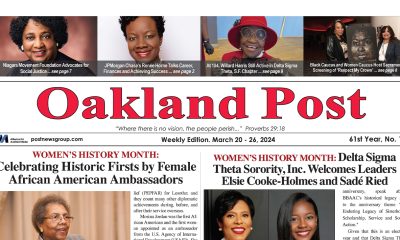
 Activism4 weeks ago
Activism4 weeks agoOakland Post: Week of March 20 – 26, 2024
-

 #NNPA BlackPress3 weeks ago
#NNPA BlackPress3 weeks agoCOMMENTARY: D.C. Crime Bill Fails to Address Root Causes of Violence and Incarceration
-

 #NNPA BlackPress3 weeks ago
#NNPA BlackPress3 weeks agoMayor, City Council President React to May 31 Closing of Birmingham-Southern College
-

 #NNPA BlackPress4 weeks ago
#NNPA BlackPress4 weeks agoCOMMENTARY: Lady Day and The Lights!
-

 #NNPA BlackPress3 weeks ago
#NNPA BlackPress3 weeks agoFrom Raids to Revelations: The Dark Turn in Sean ‘Diddy’ Combs’ Saga
-
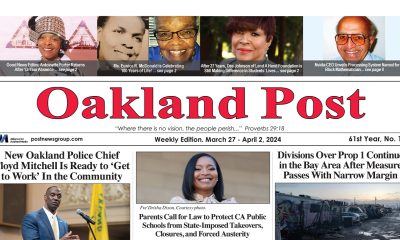
 Activism3 weeks ago
Activism3 weeks agoOakland Post: Week of March 27 – April 2, 2024
-

 #NNPA BlackPress4 weeks ago
#NNPA BlackPress4 weeks agoBaltimore Key Bridge Catastrophe: A City’s Heartbreak and a Nation’s Alarm
-

 #NNPA BlackPress3 weeks ago
#NNPA BlackPress3 weeks agoBaltimore’s Key Bridge Struck by Ship, Collapses into Water

